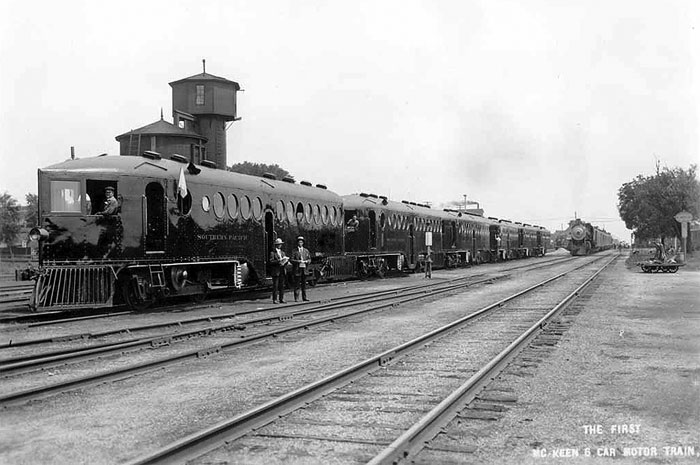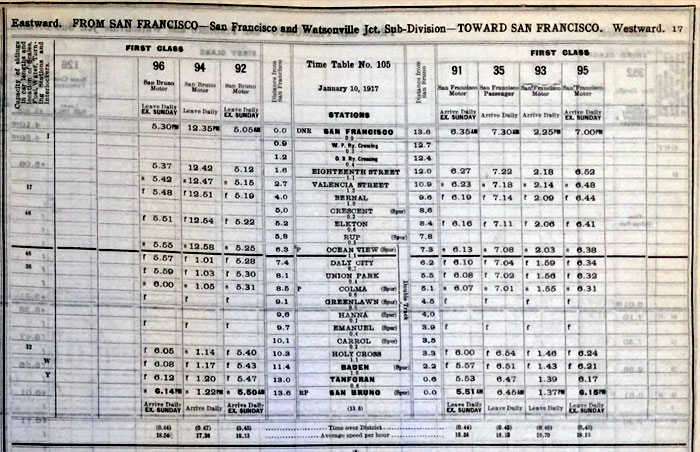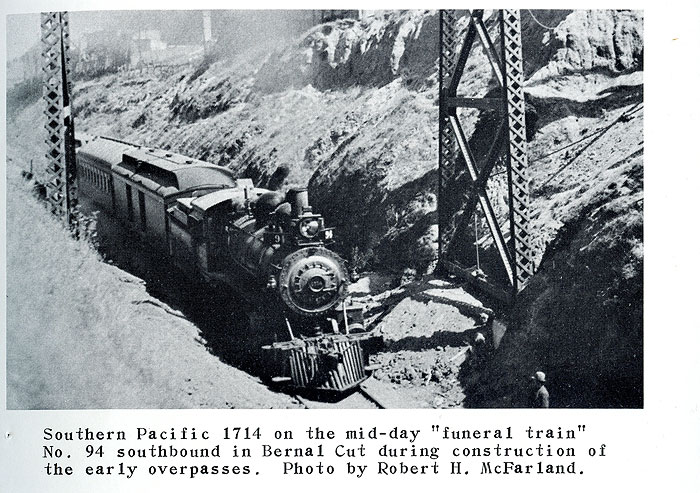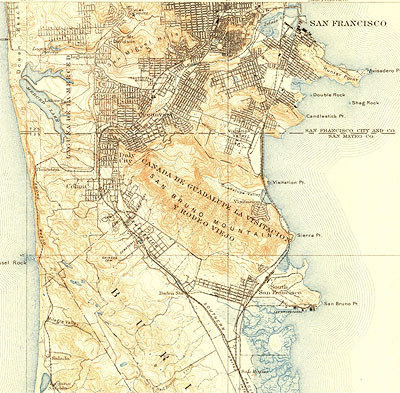The Elusive San Francisco - San Bruno "Loop" Motors
2019 UPDATE: Since this piece appeared awhile back, we have begun a more comprehensive look at the "loop" trains and their role in providing service on what we call the "San Bruno Triangle", including the little-known "passenger main" between Baden and South San Francisco. This is intended to be a supplement to Henry Bender's fine piece about South San Francisco that appeared in SPH&TS's Trainline. Stay tuned!

SP McKeen Motor Cars - presumably #'s 3, 5, 7, 9, 11 and 13, all turned out in August, 1908 - lined up as an extra train, possibly en route to delivery. Some of these cars likely worked the San Bruno Loop route. Wx4 Collection
On October 1, 1916 Southern Pacific replaced most of its remaining steam passenger trains on the Ocean View Line out of San Francisco with "Motors", presumably 55' McKeen cars. The opening of the Bayshore Cutoff in 1908 had relegated the Ocean View to secondary status, and very little through freight or passenger service subsequently traversed the line. What passenger trains that remained on the route largely ran only as far as San Bruno, where their equipment turned to head back to San Francisco under different train numbers. The Ocean View and Cutoff routes between San Francisco and San Bruno described a large loop - indeed, prior to the institution of the motors, some trains were listed in timetables as "Loop Way Pass.". Depending upon the year, one or two trains each way traversed the Loop, half leaving San Francisco via the Cutoff and returning via Ocean View. The other half ran in the reverse direction. The equipment used on the other Ocean View trains to San Bruno turned on the Tanforan Wye, then backtracked its way to San Francisco. The only other post-Cutoff passenger train to operate via the old main line was #35, which carried express (and mail?) out of San Jose for distribution to Ocean View stations.
(click on the map for a larger version) USGS 1915 map showing the San Bruno "Loop": From San Bruno (bottom), the Ocean View Line heads northwest, then east towards Ocean View, the summit. The Bayshore Cutoff runs north from San Bruno through South San Francisco and Bayshore (yards and shops on the east edge of Visitation Valley). The two routes converge on the Third & Townsend San Francisco depot near Seventh St. Note the line running from Baden Station to South San Francisco: During the mid-1890's, this was known as the "passenger main", because all passenger trains used this route from Baden to San Bruno. The more direct Baden-to-San Bruno line was reserved for freight trains. In the late 1890's, some passenger trains returned to the direct route, and all passenger service was removed from the Baden-South San Francisco segment with the opening of the Cut-Off in 1908.
Trains on the Ocean View faced stiff competition from parallel Market St. Railway interurbans, which syphoned off what little traffic there was. The locale south of San Bruno Mountain was still mostly agricultural and lightly populated. The only strong patronage came from funeral and visitor traffic to the several cemeteries in the Colma. Prior to the Cutoff's opening, almost all passenger trains operated to San Jose or other points south of San Bruno, so the costs of serving Ocean View customers was mostly absorbed by the through trains. The post Cutoff Loop trains were forced to stand on their own. Initially, eight locals (plus the one ever-present through train from San Jose) ran the Loop, but this was soon cut-back to six. By no later than 1914, eight trains (plus the San Jose train) were again working the route, attributable to the rapid population growth of the area.
Between 1914 and 1916, the rate of automobile ownership in the U.S. began to climb astronomically, particularly in rural and suburban areas served by the outlying parts of the Ocean View Line. Whether SP officials fully understood how autos were beginning to undermine passenger traffic is debatable, but they did understand absolute receipts, and in the case of Ocean View, judged that changes were in order. The thought of discontinuing all service probably was not considered seriously, if at all, because vacating the entire company presence on any significant route was anathema in management thinking of the time. Even if the economics were unsatisfactory, SP considered politics and influence (and some historians say, societal obligations) as overriding factors in continuing train service, a mindset that did not change until the company threw in the branch-line-train towel in the late 1920's.
(continued below graphics)

above - Throughout their existence, the Motor trains ran on the same schedules as seen here in the employee timetable.
below - The 90-series train numbers originated in 1910 or early 1911 during the steam train days. Here, in a photo that
appeared in the 10/1978 Western Railroader, we see mogul #1714 in charge of the mid-day "San Bruno Passenger"
out of San Francisco sometime in the 1910-16 period. Loco 1714 also worked the Willows-Hamilton (City) mixed
train at about the same time. Wx4 has a lengthy investigatory article regarding a photo of 1714 on the latter train.mi

Thus, SP decided upon substituting motor cars on six Loop trains in 1916, while two other steam trains were discontinued entirely. McKeen cars, while relatively less costly to operate, were unsuited to the service. They were exhaust and oil fume-laden boxes that resonated with motor noise. This made the nearby interurbans more attractive to riders than before. Worse, they were propelled by a single axel, making them slippery in inclement weather, of which there was considerable on the line, particularly fog which settles gently on oil-splotched rails without the cleansing effects of a good hard rain. This did not combine well with heavy Ocean View grades, particularly at Valencia Street, where a few years before SP discontinued the stop for several eastbound (southbound) trains due to difficulty in leaving the station. Forty-odd years ago, a Felton resident told me of how the McKeens on the uphill school trains that he rode out of Santa Cruz to his town regularly slipped and stalled on the grade, necessitating the kids to get out and push. Though this may be a myth, it does address a general awareness of McKeens' less than sure-footed nature.
The combination of the somewhat repulsive nature of the McKeens along with the ever-increasing number of automobiles virtually insured that the new setup would fail, and it did less than two years later. On June 2, 1918 a new schedule came out minus the six motor trains. All that remained were two through steam passenger trains to and from San Jose. Later, these trains were replaced by a pair of Ocean View Line trains to and from San Bruno, the final arrangement until the end of passenger service in 1928.
Perhaps an indication of how reviled the McKeens were is that no photo has yet to surface depicting one in San Bruno Loop service. Likewise, there is no available indication about which actual cars worked on the route, let alone their distribution between 55' and 70' models, though 55' seems more likely. It's all a mystery. Hopefully a photo will surface someday.

